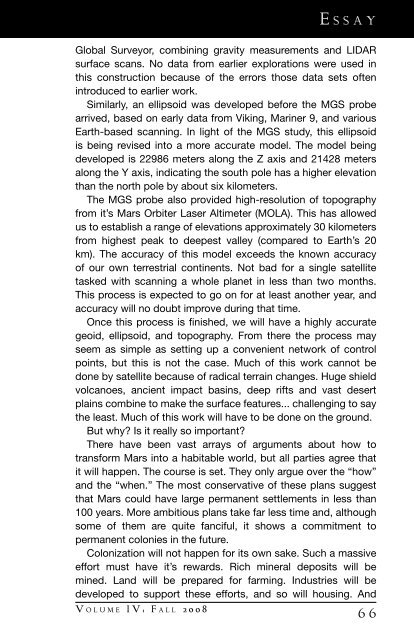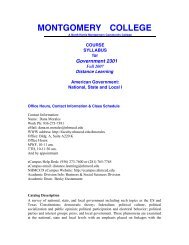2008 - Communication Across the Curriculum (CAC)
2008 - Communication Across the Curriculum (CAC)
2008 - Communication Across the Curriculum (CAC)
You also want an ePaper? Increase the reach of your titles
YUMPU automatically turns print PDFs into web optimized ePapers that Google loves.
E s s a y<br />
Global Surveyor, combining gravity measurements and LIDAR<br />
surface scans. No data from earlier explorations were used in<br />
this construction because of <strong>the</strong> errors those data sets often<br />
introduced to earlier work.<br />
Similarly, an ellipsoid was developed before <strong>the</strong> MGS probe<br />
arrived, based on early data from Viking, Mariner 9, and various<br />
Earth-based scanning. In light of <strong>the</strong> MGS study, this ellipsoid<br />
is being revised into a more accurate model. The model being<br />
developed is 22986 meters along <strong>the</strong> Z axis and 21428 meters<br />
along <strong>the</strong> Y axis, indicating <strong>the</strong> south pole has a higher elevation<br />
than <strong>the</strong> north pole by about six kilometers.<br />
The MGS probe also provided high-resolution of topography<br />
from it’s Mars Orbiter Laser Altimeter (MOLA). This has allowed<br />
us to establish a range of elevations approximately 30 kilometers<br />
from highest peak to deepest valley (compared to Earth’s 20<br />
km). The accuracy of this model exceeds <strong>the</strong> known accuracy<br />
of our own terrestrial continents. Not bad for a single satellite<br />
tasked with scanning a whole planet in less than two months.<br />
This process is expected to go on for at least ano<strong>the</strong>r year, and<br />
accuracy will no doubt improve during that time.<br />
Once this process is finished, we will have a highly accurate<br />
geoid, ellipsoid, and topography. From <strong>the</strong>re <strong>the</strong> process may<br />
seem as simple as setting up a convenient network of control<br />
points, but this is not <strong>the</strong> case. Much of this work cannot be<br />
done by satellite because of radical terrain changes. Huge shield<br />
volcanoes, ancient impact basins, deep rifts and vast desert<br />
plains combine to make <strong>the</strong> surface features... challenging to say<br />
<strong>the</strong> least. Much of this work will have to be done on <strong>the</strong> ground.<br />
But why Is it really so important<br />
There have been vast arrays of arguments about how to<br />
transform Mars into a habitable world, but all parties agree that<br />
it will happen. The course is set. They only argue over <strong>the</strong> “how”<br />
and <strong>the</strong> “when.” The most conservative of <strong>the</strong>se plans suggest<br />
that Mars could have large permanent settlements in less than<br />
100 years. More ambitious plans take far less time and, although<br />
some of <strong>the</strong>m are quite fanciful, it shows a commitment to<br />
permanent colonies in <strong>the</strong> future.<br />
Colonization will not happen for its own sake. Such a massive<br />
effort must have it’s rewards. Rich mineral deposits will be<br />
mined. Land will be prepared for farming. Industries will be<br />
developed to support <strong>the</strong>se efforts, and so will housing. And<br />
V o l u m e I V : F a l l 2 0 0 8<br />
6 6






